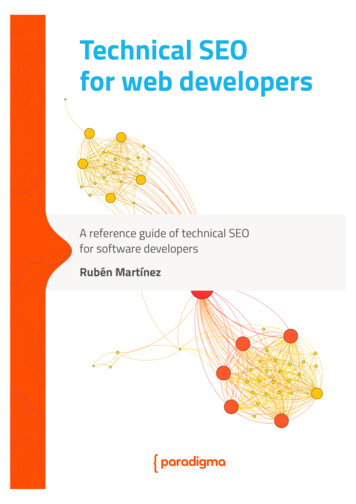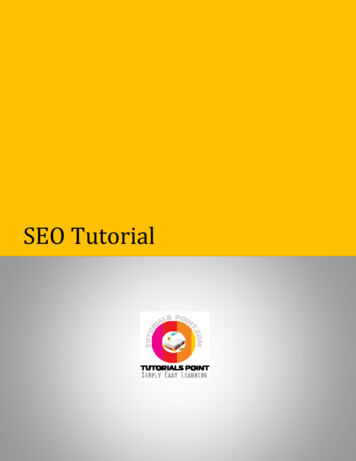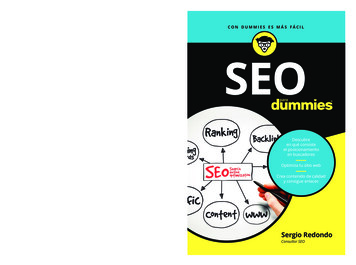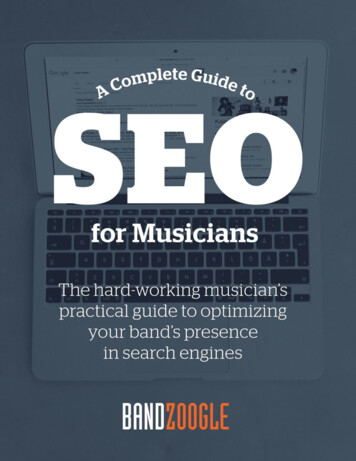
Transcription
Technical SEOfor web developersA reference guide of technical SEOfor software developersRubén Martínez
SEO for Web DevelopersTable of ContentsIntroduction . 4Disclaimer. 4About the author . 4Special thanks . 5What is SEO? . 6Which are the differences between technical and off-page SEO? . 6Why is SEO important? . 7Is SEO free? . 8Google’s official stance on SEO . 8Jargon buster . 9SEO deals with the bottlenecks in the search flow. 12Bottleneck 1: Limitations of keywords . 13Bottleneck 2: The World Wide Web & Search Engines . 15Bottleneck 3: Web servers, websites and code . 15Bottleneck 4: The content itself . 15SEO for new websites . 17Why is technical SEO relevant?. 17Hosting . 17Host your site on reliable servers with excellent connectivity . 17Check your neighbours in shared hosting environments . 18Hosting services with dynamic IP addresss . 19Information Architecture . 19Google PageRank . 19Design a lean site architecture. 19Link your internal pages sensibly . 21Configuration of mobile rendering . 27Uniform Resource Identifier URL . 28URI Syntax . 28Compose a simple URL path . 28URL encoding . 29Friendly URLs. 291Paradigma Tecnolgico – Rubén Martínez
SEO for Web DevelopersAutomate the generation of URLs with intuitive rules . 31Mark-up your content . 32Title Tag . 32Meta elements . 32Headings. 34Main and aside tags . 34Rich media (images, videos) . 34Canonicalization . 35Anchor text. 35Structured Data . 36Authorship. 37Robots.txt protocol . 38Monitor your site for hacked content . 39HTML, JavaScript, AJAX and CSS . 39Code for speed . 39Debug for crawlers . 40Avoid cloaking . 40Make AJAX content crawlable . 40 noscript tag for content on JavaScript . 42Avoid frames and Flash . 43Avoid using CSS to hide text . 43Generate sitemaps . 44HTML sitemaps. 44XML sitemaps . 46If-Modified-Since HTTP header . 47Set the crawling rate of Googlebot . 47SEO for established websites . 48Off-page SEO . 49Backlinks. 49Quantity of backlinks . 49Quality of backlinks . 51Growth rate of backlinks . 52Content inventory . 53Internal duplication . 53Plagiarism . 532Paradigma Tecnolgico – Rubén Martínez
SEO for Web DevelopersCount of indexed pages . 53HTTP Status Codes . 54Server-side redirects . 55Migration from older versions or consolidated properties . 56Manage the rotation of content . 56Site Architecture . 57First step – Crawl a website . 57Second step - Filter the pages with internal links only . 57Third and last step - Visualize the network and analyze it . 58Watch the health of your site . 61Crawling by Google . 61Server logs . 62Health check of indexed URLs . 63Log file parsing . 64Block bots other than search engines. 64Tools and references . 65What now? . 66Epilogue. 66Appendix – Google Updates . 67SERP volatility. 67Appendix – Target keywords . 69Appendix – Domain names . 71Internationalization of domains . 71Subdomains and subfolders. 72Appendix - Google Analytics . 73Engagement . 74Split or A/B tests . 75Licensing . 76References . 773Paradigma Tecnolgico – Rubén Martínez
SEO for Web DevelopersIntroductionThe goal of this document is to be a quick reference handbook for webdevelopers, either back and front-end ones. It should also help demystifythe some of the many stereotypes about SEO.This book will help you and your clients speak the same language witheach other and with in-house or consulting specialists.This eBook is a work in progress. This is the 2nd version with a deeprevision of the first edition published in 2013. The most recent version ofthis book is available to download at paradig.ma/ebook-SEOThis work is distributed under the Creative Commons AttributionNonCommercial-NoDerivs 3.0 Unported License. You must giveappropriate credit to Paradigma and the author. You should not use thematerial or part of it for commercial purposes.We are looking for translators of this eBook. Please contact us fortranslations to other languages.DisclaimerThe examples on this document are provided for illustration purposesonly and in good faith. The author does not endorse or otherwise themerits or lack thereof the websites and tools mentioned on this eBook.About the authorRubén Martínez is a marketer with a vast experience in international andmultilingual SEO. Rubén learned the basics of online marketing whilelaunching his start-up in London, United Kingdom.Later on, as a team member of another start-up, Lokku, Rubéncontributed to the growth of Nestoria, a smart property search enginelaunched from London to 9 countries in 6 languages.4Paradigma Tecnolgico – Rubén Martínez
SEO for Web DevelopersRubén deals with all things inbound marketing, analytics, SEM and SEO atParadigma in Madrid, Spain. Paradigma is a 150 strong Big Data and websoftware development company offering innovative technology forbusiness world-wide.Special thanksMany people contributed to this eBook in a way or another, not the leastby asking great questions or by patiently answering mine.Oscar Méndez at Paradigma accepted my proposal to write this eBook inthe first place. María Arana, Mike Astle, Juan Cantero, Marc TobiasMetten and Gonzalo Alamar and a few others helped to turn my notesinto this eBook.5Paradigma Tecnolgico – Rubén Martínez
SEO for Web DevelopersWhat is SEO?SEO stands for Search Engine Optimization. SEO is everything that helpsa website generate more revenue by converting traffic from searchengines into leads or purchases.SEO is traditionally identified with the techniques that help improve therankings of web pages on Google – this was just one of the visible effectsof SEO.The basics of SEO can be applied not only to generic search engines likeGoogle, Baidu or Yandex but also to vertical ones like Indeed or Yelp,social networking services like Facebook or LinkedIn and to virtually allrepositories of content with search engine functionalities.This eBook focuses on SEO for Google because most of users have astrong preference for Google, not only as a generic search engine, butalso as their gateway to the Internet.E.g. when a user thinks about checking a movie on the Internet MovieDatabase website, he or she will often just write “imdb” on Google andclick on the first result rather than directly typing the domain name andextension “imdb.com” in the address bar of their browser.Which are the differences between technical and off-page SEO?Two SEO approaches are required to drive users from search engines towebsites: technical SEO and off-page SEO.Technical SEO is everything related to a page and a website that is underthe direct and usually immediate control of web developers andwebmasters. This document is focused on technical SEO almostexclusively.Off-page SEO is everything external to the development of a website likecontent marketing, link building and social sharing, which are not underthe direct control of developers and webmasters.In the early days of Internet, search engines simply did not use links as aranking factor. Websites managed to show up on search engines’ results6Paradigma Tecnolgico – Rubén Martínez
SEO for Web Developersjust by minding basic on-page SEO guidelines, like inserting titles on theirHTML documents.In addition to on-page and off-page SEO, content marketing is the otheressential component for a sustainable and profitable online business.Why is SEO important?Being visible and ranking high on Google results not only in inboundtraffic, but also in trustworthiness, authority or empowerment ofprescription for websites and businesses of all sizes, markets andlanguages.Figure. Screenshot of Google search box for the query “why is SEO”. The search enginesuggests auto-completions of related queriesWashingtonpost.com is a news website. It enjoys the massive awarenessand brand reputation of its offline precursor, The Washington Post. Youmight think that the newspaper does not “need” Google for its business.The website however actively helps Google find all of the content byposting a comprehensive and updated sitemap.The file http://www.washingtonpost.com/robots.txt includes the line:Sitemap: By pointing the crawling bots to its sitemap, The Washington Post isinvesting in their SEO for profit.7Paradigma Tecnolgico – Rubén Martínez
SEO for Web DevelopersIs SEO free?SEO is definitely not free. It is however hugely cost-effective incomparison to any other investment in the marketing mix.In addition to getting good training and reading books like this one, wegenerally advise to work with professional SEOs and digital strategists tosave time and resources later in the lifetime your project.Long term success in search marketing requires best practises,experience and intuition. SEO has a reputation of being a trade restrictedto a few in the know. This stereotype is rooted in the fact that, so far,there is no tool, automated method or machine learning approach thatmanages to squeeze all the value of all the SEO developments. That iswhy you will not find “SEO tricks” on this eBook.Organic traffic flows in when great content meets good SEO. Content isKing - as long as it is fresh, relevant or engaging. SEO just makes it easyfor bots to find, index and rank websites with the right content. Howevereven the best content needs to be published efficiently so that searchengines find it and deal with it.The conclusion is that good SEO requires experts and content, neither ofwhich come cheap, but it generates potentially massive amounts oftraffic with high rates of conversion over the long term.Google’s official stance on SEOWhile many affiliates and some SEOs are known for trying tosystematically out-smart search engines with short term tactics, the bestpractice SEO requires patience, experience, good relations within thesearch industry, great communication skills and, above all, an avidcuriosity.Google recently claimed that “Many SEOs and other agencies andconsultants provide useful services for website owners”i.The relationship between Google and the marketing industry is rich andcomplex. Google communicates regularly with the SEO industry and8Paradigma Tecnolgico – Rubén Martínez
SEO for Web Developersprovide tools, posts on forums by Google employees, videosii, etc towebmasters and marketers.Jargon busterThese terms will help you understand some of the concepts used in thiseBook. We list them in alphabetical order and some of them are a bitabstract but please soldier on:AJAX is a number of techniques to create client-side asynchronousweb applications brought together by JavaScript. Rich featuresusing AJAX are popular because they usually improve the userexperience by efficiently refreshing content. AJAX is however anissue for Google’s crawler because it cannot read its content.Google expects that developers carry out some extensive hackingto deal with AJAX (see section “Make AJAX crawl-able” below).Backlinks or inbound links are links from external websitespointing to another website as opposed to internal links frompages on one website to other pages on the same site. Backlinksare not to be confused with the links to search results on GoogleSERPs.Corpus is a collection of documents in a machine-readable format,usually text. Examples of corpora (plural of corpus) are dumps ofdatabases of any nature and format, the scraping of a website orany number of websites, etc.Crawler or web spider is a bot programmed to browsesystematically websites for the purpose of indexing, like GooglebotCTR stands for Click Through Rate or clicks on a search resultdivided by the number of impressions (or how many times itshowed on any SERP)Document is a piece of text or rich media that can be accessed andstored individually. An example of a document is a webpage or adownloadable pdf file.Graph is the interconnection between documents (vertices) byedges (links). An example of a graph is the network of websiteslinked with each other.9Paradigma Tecnolgico – Rubén Martínez
SEO for Web DevelopersFigure 1 of a graph of 5 million edges and an estimated 50 million hop count by the Opteproject modelling the Internet in 2003. Colours modified from the original representingdifferent regions of IP addresses like Asia Pacific, Europe, North and South America, etc.The concept of graph is a key concept in SEO. Many projects of newwebsites usually start their life as the output of a number offunctionalities and ad-hoc extensions, rather than a body ofinterconnections. Search engines and SEOs however think of websitesand actually the entire Internet as a graph.Information Architecture (abbreviated as IA) is the organization ofdocuments and their connections. Websites are, in terms of IA,dynamic and connected structures of bot-readable content.Technical SEO is mostly applied IA for search.PageRank is a metric used by Google to determine the importanceof an element (e.g. document, graphs or parts of them). It is one ofmore than 200 factors used to determine rankings of searchresults on Google. SEOs tend to prefer concepts like link juice orauthority and new metrics to Google’s PageRank.10Paradigma Tecnolgico – Rubén Martínez
SEO for Web DevelopersSEOs or search marketers are professional practitioners of SEO.SERP is the acronym of Search Engine Results Page or the list oflinks to results that search engines return in response to a user’squery, e.g. http://www.google.com/#output search&q serpSilos are groups of subject-specific content on websites, e.g.categories separated as tree or sub-categories and detail pages.Vertical silos are frequent in tree structures where category pagesare linking down to sub-category pages. The webpages under silosare hardly linked with webpages of other silos, i.e. there are few orno transversal or cross links across silos.11Paradigma Tecnolgico – Rubén Martínez
SEO for Web DevelopersSEO deals with the bottlenecks in the search flowSEO exists because people think and write in a different way from howsearch engines work.There are a number of components in the search process that result inbottlenecks in the flow of information. The bottlenecks are inefficienciesthat may result in a poor match between the search intent of the userand the purpose of the author or publisher.Figure 2 the flow of search is represented on the diagram above from the left (users) to theright (content). There are a few bottlenecks that affect the efficiency of the search.SEOs can only try to understand, but not influence, the systemicbottlenecks: from the true meaning of keywords and search intent toGoogle’s limitations.Web developers and SEOs can optimize or have a direct control over therest of bottlenecks down the flow: mostly speed, structure and thecontent itself.12Paradigma Tecnolgico – Rubén Martínez
SEO for Web DevelopersBottleneck 1: Limitations of keywordsMeaning of keywordsMany words convey different meanings. This is a challenge both forsearch engines and for SEOs.E.g. “Metro” is a word that, when combined with the name of a locationas in “metro {location}”, might mean different searches in Europe,Canada and US:- a local railway transport- a local section of a newspaper or local news paper- a brand of food storesSearch intentThere are a few possible search intents:- Informational: wikis, news, blogs and publishing sites- Navigational: video hosts, social networks- Commercial: informational search with future transactionalimplications, e.g. vertical search engines, classified aggregators,price comparison sites- Transactional: retail, e-commerce sitesGoogle tries to estimate search intent from users’ previous activity andcontext but it is a formidable challenge for a generic search engine.Changes in business models are often followed by SEO adjusting todifferent search intent than the one previously targeted.E.g. When paywalls are introduced in newspapers, their SEO adjusts frominformational intent (advertising intermingled with content) totransactional intent (content only with restricted access).Google search featuresThe average number of words per query by users increased steadily from2 to 4 search terms (excluding stop words) in the last few years. Weusers educated ourselves to write longer queries.13Paradigma Tecnolgico – Rubén Martínez
SEO for Web DevelopersGoogle recently started to alter the search behaviour of users by limitingthe long tail of search queries by tapping into the search data of users:- Auto-complete search suggestions: Google displays suggestionsthat might be related to the one you are typing. This influencesyour query by modifying it or by accepting the one Googlesuggests instead of the one you originally intended to write.E.g. when you type just “bank”, Google suggestsBank of AmericaBankBank of Scotland- Google Instant: Google updates its SERP with different results asyou type your query in the search box. This deters many usersfrom typing queries longer than three or four search termsbecause they are presented with results earlier on.Search engines’ biasBrands, media titles, universities and institutions are said to be overrepresented on Google SERPs. Google probably deals with entities intheir graph and training dataset that might be equivalent to what wehumans refer to as brands.Google discretionary classifies reputation and authority of those entitiesaccording to their undisclosed criteria. Google adjusts their criterialogarithmically or with manual actions.When Google releases multiple or significant adjustments at the sametime, a significant amount of websites might be affected. Thesesituations are known as updates. The best known recent updates arecalled Google Panda and Penguin.14Paradigma Tecnolgico – Rubén Martínez
SEO for Web DevelopersBottleneck 2: The World Wide Web & Search EnginesThe World Wide Web (WWW) is an unstructured, de-centralized andever changing ecosystem. Google tries to make sense of it with differenttypes of software:- Crawling software: bots are fast and greedy but blind to whateveris not text. Search engines try to cope with users creatingincomplete, biased or inadequate connections between pieces ofinformation. Google in particular is trying to cope with the surge ofsocial networks.The quality of links as indicators of relevancy or popularity is alsoevolving: it is more convenient to link to content via social sharesthan with traditional hyperlinks on web pages.- Indexing software: the main current challenges are identifyingunique content and attributing authorship. Valuable content isoften very duplicated across the WWW.- Ranking software: Google claims to fight web spam with trainingdata built for machine learning algorithms allegedly used for userspecific and session-specific rankings.Bottleneck 3: Web servers, websites and codeThe performance of websites in terms of access to findable content anddownloading speed depends on two main factors:Site architecture: the distribution of the information in a structureof categories or sections organised by topic and other criteriaPage speed: from the point of view of the crawlers, the codeengineered for simplicity and speed is key for downloading thecontent from the server fastWhen the speed of the web servers or the availability of networks ispoor, the flow of information gets disrupted.Bottleneck 4: The content itselfThe publication of the content can itself be a bottleneck. SEO optimizesthe IA of the content to match the requirements of search engines:15Paradigma Tecnolgico – Rubén Martínez
SEO for Web DevelopersMark-up: Poor or missing tagging frequently leaves search engines toclassify content on their own without the help from its publishers.Format: Search engines are good at interpreting text only. They only getthe mark-up of images and videos – if it exists at all. All the client-sideinteraction with AJAX, Flash content, etc. are totally lost to searchengines.Duplication: If there are duplicated versions of the same content inmultiple documents, search engines have trouble identifying the originaldocument or even the first to be detected.Attribution: Attribution of authorship is, like uniqueness, a hard issue forsearch engines to deal with.16Paradigma Tecnolgico – Rubén Martínez
SEO for Web DevelopersSEO for new websitesWeb developers that pay attention to on-page SEO in the early stages ofnew projects usually save lots time once in production. Critically, a wellthought-through site architecture and prioritization of conversion funnelsscale up beautifully.We list below those SEO techniques that you need to consider in loosechronological order:Why is technical SEO relevant?Nowadays on-page SEO remains an important technique in the onlinemarketing toolbox because:1. Web servers and search engines only have in common the fact thatthey are extremely fast but essentially dumb machines. Thetechnical SEO helps close the gap between both systems.2. Search engines fall short of the expectations of users: it is veryhard to determine search intent of a query, never mind matching itwith the purpose of the content.SEO helps close the gap between software and users and minimize theirlimitations.HostingHost your site on reliable servers with excellent connectivityYou need a server uptime of 99.9% or higher over any period of time andas much bandwidth, memory and processing power as it takes. The goodnews is that all of the infrastructure costs keep dropping in price overtime.Measure the number of hops from your LAN the host of your website. Ifyou are using a well interconnected local ISP, chances are that thenumber of hops that
Two SEO approaches are required to drive users from search engines to websites: technical SEO and off-page SEO. Technical SEO is everything related to a page and a website that is under the direct and usually immediate control of web developers and webmasters. This document is focused on technical SEO almost exclusively.










